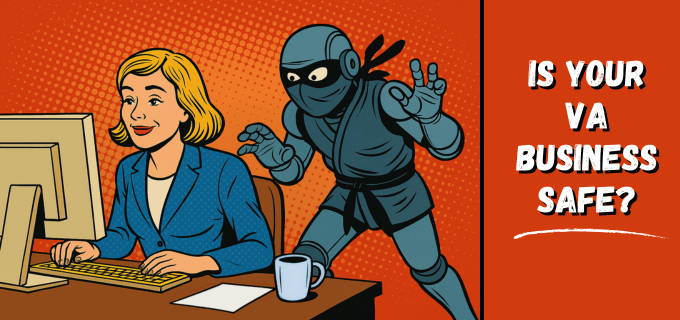In an incredibly short period of time, the world has gone from barely any AI to it being absolutely everywhere. The speed seems to double every few days, and the constant updates and developments are enough to make your head spin. But is it a threat to the Virtual Assistant industry, and if so, what can we do about it? Let’s ask it, shall we?
TL;DR (but honestly, it’s worth reading the full post!):
- AI won’t replace Virtual Assistants, but it will shift what clients want.
- Low-skill, repetitive tasks are most at risk.
- VAs who build niche knowledge, offer high-trust services, and act as strategic partners will thrive.
- Some of your clients may soon be affected.
- Switch to value/outcome-based pricing rather than time-based pricing, as you complete tasks faster.
Read more to find out exactly where the risks are and learn how to futureproof yourself.
What the AI boom means for Virtual Assistants
Fortunately, Virtual Assistants seem to do well in every economic climate and situation because there will always be businesses, and businesses will always need a hand.
However, what those businesses are and what they need help with are not always a given.
In order to help you futureproof your VA business – in terms of the niche you serve, the clients you work with and the services you offer – I wanted to find out which jobs are imminently at risk from the unstoppable rise of AI.
To do that, I simply asked ChatGPT and Claude, “What jobs do you think will NOT be replaced by AI in the next year or so?”
The jobs AI says are safe from disruption
These are the current “safe” jobs according to ChatGPT and Claude:
In the next year or so, there are plenty of jobs that are highly unlikely to be replaced by AI. Mostly because they rely on:
- Complex human interaction
- Creative and strategic leadership
- Physical presence or dexterity
- High trust, nuance, or emotional intelligence
- Regulatory or legal restrictions
- Public safety
Examples they provided included tradespeople, therapists, educators, healthcare workers, and anyone in regulated industries (like law and medicine) where a human is legally required.
However, they also provided this caveat:
AI will increasingly become a co-pilot or productivity booster in many of these fields. So while the jobs won’t be replaced, the tasks within them might shift.
Both LLMs said safer industries would be “those that rely heavily on trust, human experience, and emotional context as AI can’t form real relationships (yet).”
Yet…
Ironically, industries that were hit the hardest during the pandemic were events, travel, brick and mortar businesses, tradesmen and anyone else who had hands-on contact with the public.
And now these may be the industries least at risk from AI.
This is a similar drip-down situation to the pandemic years – if your clients are impacted by global changes, then your VA business will be too.
Are Virtual Assistants at risk from AI?
In addition to the risk of your client’s industries (or the industries they serve) being negatively affected by AI, I wanted to know if there will be any direct challenges to Virtual Assistants in terms of the services they provide.
Because, while I don’t currently see VAs having any issues, forewarned is forearmed.
Here is what ChatGPT and Claude have to say on the threat of AI to VAs (directly quoted):
Virtual assistants face a mixed landscape – some of their services are at high risk from AI automation, while others remain relatively safe.
At-risk services include:
- Basic data entry, transcription.
- Simple email management.
- Basic research tasks.
- Calendar scheduling for routine appointments.
- Basic content creation, such as simple blog posts, social media updates, and generic marketing copy.
However, Virtual Assistants are safe if their job involves:
Specialised industry knowledge
VAs with deep expertise in specific sectors (legal, medical, technical) remain valuable because they understand industry-specific processes and terminology.
Complex project management
Coordinating multiple stakeholders, handling nuanced client relationships, and managing complex workflows requires human judgment and adaptability.
High-touch client relationship management
Building genuine relationships, understanding client preferences, and providing personalised service experiences.
Creative strategy and planning
Developing marketing strategies, campaign planning, and creative ideation that require an understanding of brand voice and market nuances.
Technical troubleshooting
Solving complex software issues, managing integrations, and handling technical problems that require adaptive thinking.
Customer service that requires empathy
Handling sensitive customer issues, complaints, or situations requiring emotional intelligence and genuine problem-solving.
Claude summarised it as:
“The VAs most likely to thrive will be those who specialise in higher-value services, develop niche expertise, and position themselves as strategic partners rather than task executors.”
My thoughts
I agree with Claude that VAs who specialise in higher-value services, have niche expertise, and position themselves as strategic partners will thrive in the coming years.
AI can’t read the room, interpret nuance or determine if a situation is about to escalate or needs delicate handling. So I think any VA that manages communities, projects, high-value relationships, and personalised customer service will be safe.
Because people do business with people.
So while larger companies may use AI for their first-touch customer service, if a customer has a problem, eventually, they want to speak with a real-life person.
However, while ChatGPT felt that social media tasks such as writing copy were safe, Claude did not.
In my opinion, I can feel a backlash against AI-generated content coming. AI images are fine, but AI copy is really shonky. Yes, you can teach AI how you speak and write, but it can’t write like a real person. (And I hope it never does).
Humans crave connection and authenticity, and any content that reeks of inauthenticity is hugely off-putting to the person reading it.
AI is great at coming up with ideas and polishing copy, but if people want what they write to resonate with others on a personal level (which is the point of creating content), it won’t.
We’ve all played around with AI-generated content. I’m definitely guilty of trying out AI-assisted posts and not editing them enough, but when I’ve read them back, they just don’t sound right.
The content doesn’t sound like a real person because it isn’t.
IMO, AI-assisted content is excellent as a starting point, but getting it to generate ideas and content you can rewrite in your own voice is far better.
So, while many people are currently using AI for their content, I can already see the pendulum start to swing back the other way as we all become irritated by it.
How to AI-proof your Virtual Assistant business
The advice Claude gave is not new, and I have also been sharing this advice for years in my blog posts, guides, downloads, newsletters, courses, social media posts and videos.
Basically, it’s stuff VAs should already be doing.
The best way to future-proof your Virtual Assistant business against any threat, not just from AI, is to prioritise client relationships and provide value.
1. Position yourself as a strategic support partner
It’s pretty easy to help your clients when you understand their goals and what they want to achieve in the long run.
- Understand your client’s end result. What’s their ultimate goal behind the tasks they give you?
- Ask lots of questions during your discovery call and onboarding process.
- Offer ideas and suggestions. If you know how to create newsletters, for example, and the client doesn’t have one, then suggest it. Be specific and tell them exactly how their newsletter could be awesome.
2. Use AI but add the human touch
Clients don’t want an out-of-date VA, and AI can help you do the same task in half the time, but…
- Use ChatGPT to draft, then humanise the output so it sounds like a real person.
- Help your clients stay up to date with the biggest and most useful AI changes. They’re busy and don’t have time to figure out a load of new tech. That’s why they hired an assistant.
3. Build industry or task knowledge
AI is a generalist, so position yourself as a specialist.
- Choose a niche that’s less likely to be impacted by AI. Or at least risk assess your current niches.
- Position yourself as the go-to VA for that type of business, client, industry, software, or task. You do this through your website and social media content.
- Elaborate on how you can help. Change the vague “I support online course creators” to what you actually do: “I work with online course creators to manage launches, build email sequences, and support students post-enrolment. I’m familiar with Kajabi, Teachable, ActiveCampaign, etc, etc”
4. Offer high-trust services
People want humans for sensitive, complex, or awkward stuff, such as:
- Personalised inbox management and customer service. AI cannot tell if someone is being passive-aggressive or if they require a delicate response or phone call.
- Podcast/interview guest coordination
- Personalised member or client onboarding
- Private community moderation or management
Basically, services that need a nuanced or personal response. I actually think many businesses will soon try to stand out with a USP of not using automated or AI customer service.
5. Show your value in outcomes
Using AI tools means you can complete tasks much faster, so you should be charging for the task and not the time.
This means replacing time-based pricing with value-based pricing.
- Start incorporating outcome-based packages and descriptions. They won’t work for every service, but the hourly rate model will leave you poorer the better/faster you get.
- Track and show the results (saved time, increased conversion, smoother systems etc). Basically, you want to describe the value of the end result rather than flatly describe the task itself.
I’m currently creating a guide on how to package up your services, but as an example, a newsletter will result in more customers, revenue and engagement for a client.
So, if you know how to set up newsletter autoresponders or even write newsletter content, you should describe the value of this service rather than just describing the service itself.
Next Steps
- Choose one AI tool to experiment with each month. You can’t learn everything, so focus on staying abreast of changes and tools in your client’s industries or around services you offer.
- Ask ChatGPT, Claude or Gemini to run a SWOT analysis on your business. Provide the services you offer and the industries you work with, and ask if they are at risk and how you can futureproof yourself.
- Make sure you have an AI clause in your Virtual Assistant contract.
- Build closer connections with your clients. They should see you as a valued team member rather than just a task ticker.
- Leading on from this point, share useful tips and resources with your clients to show you’re invested in their business. This is as simple as pinging them industry updates or articles they may find interesting.
- Download my free 12-month social media content guide and get a full-ass year of ideas tailored just for VAs. This will help you write more niche-focused content.
- Complete these disaster recovery exercises because an AI isn’t the only threat to your business.
- If you have any ideas or observations about the way your clients are doing things, then offer better solutions. This is another example of showing your value. Here are some additional tasks you could suggest.

Oh, and subscribe to Espresso AI!
AI is here to stay, and if you don’t keep up, you’re going to be left behind – so I created a monthly AI newsletter to make sure you don’t.
No complicated tech-bro stuff, just clear, bite-sized info that you can apply directly to your VA business.





I took a class introducing me to AI and after the class it gave me nervous feelings and when the question was posed to the presenter about how secure AI is?
He told us to be careful….
I have not used AI or donot plan too.
This is completely up to you, of course. It is however the equivelent of a secretary saying in the 90’s they are not going to use the Internet or a delivery river saying they are not going to start using a van and sticking to a horse and cart. Clients will expect a modern Virtual Assistant so they can stay up to date.